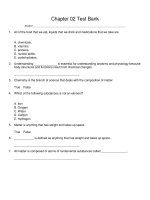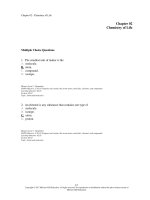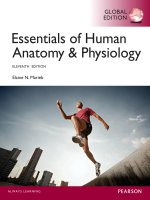Human anatomy and physiology
Bạn đang xem bản rút gọn của tài liệu. Xem và tải ngay bản đầy đủ của tài liệu tại đây (11.3 MB, 428 trang )
LECTURE NOTES
For Nursing Students
Human Anatomy
and Physiology
Nega Assefa
Alemaya University
Yosief Tsige
Jimma University
In collaboration with the Ethiopia Public Health Training Initiative, The Carter Center,
the Ethiopia Ministry of Health, and the Ethiopia Ministry of Education
2003
Funded under USAID Cooperative Agreement No. 663-A-00-00-0358-00.
Produced in collaboration with the Ethiopia Public Health Training Initiative, The Carter
Center, the Ethiopia Ministry of Health, and the Ethiopia Ministry of Education.
Important Guidelines for Printing and Photocopying
Limited permission is granted free of charge to print or photocopy all pages of this
publication for educational, not-for-profit use by health care workers, students or
faculty. All copies must retain all author credits and copyright notices included in the
original document. Under no circumstances is it permissible to sell or distribute on a
commercial basis, or to claim authorship of, copies of material reproduced from this
publication.
©2003 by Nega Assefa and Yosief Tsige
All rights reserved. Except as expressly provided above, no part of this publication may
be reproduced or transmitted in any form or by any means, electronic or mechanical,
including photocopying, recording, or by any information storage and retrieval system,
without written permission of the author or authors.
This material is intended for educational use only by practicing health care workers or
students and faculty in a health care field.
Human Anatomy and Physiology
Preface
There is a shortage in Ethiopia of teaching / learning material
in the area of anatomy and physicalogy for nurses. The Carter
Center EPHTI appreciating the problem and promoted the
development of this lecture note that could help both the
teachers and students.
Human anatomy and physiology is more than just interesting,
it is fascinating. To help get the students and instructions
involved in the study of this subject, a number of special
features are incorporated throughout the lecture note.
The lecture note provides a thorough review of human
anatomy and physiology applicable to the nurses. It covers all
body parts using a systemic approach. Each chapter is
designed to aid effective student learning.
Each chapter contains:
-
The Learning objectives: what the students are expected
to accomplish upon completion of a particular chapter.
-
Key concepts: summary of selected key terms included in
the chapter.
-
Illustrations: there will aid the students to achieve a better
understanding of the subject matter.
i
Human Anatomy and Physiology
-
Review questions: a cross check to know if the students
have come to grasp concepts stated in the chapter.
We hope that you enjoy the lecture note of Human Anatomy
and Physiology for nurses. Please let us know if you have any
comments regarding this lecture note.
ii
Human Anatomy and Physiology
Acknowledgments
We are highly indebted to acknowledge the authors of the
reference books we used in preparing this lecture note. We
would like to extend our appreciation to the different
professionals involved in reviewing this manuscript through its
process specially Dr. Yamrot Kinfu, Head, Department of
Anatomy, Medical Faculty, AAU. We are also grateful to The
Carter Center EPHTI for facilitating the preparation of this
lecture note. Our gratitude also goes to the assistance offered
by Jimma and Alemaya Universities for facilitating the
opportunities and resources utilized to develop the lecture
note.
iii
Human Anatomy and Physiology
Table of Contents
Preface
Acknowledgement
Table of contents
List of tables
Abbreviations
Introduction
CHAPTER ONE – INTRODUCTION TO HUMAN
ANATOMY AND PHYSIOLOGY
CHAPTER TWO – CELL
CHAPTER THREE – TISSUES AND MEMBRANE
CHAPTER FOUR – THE INTEGUMENTARY SYSTEM
CHAPTER FIVE – THE SKELETAL SYSTEM
CHAPTER SIX – THE MUSCULAR SYSTEM
CHAPTER SEVEN – THE NERVOUS SYSTEM
CHAPTER EIGHT – THE ENDOCRINE SYSTEM
CHAPTER NINE – CARDIOVASCULAR SYSTEM
CHAPTER TEN – RESPIRATORY SYSTEM
CHAPTER ELEVEN – DIGESTIVE SYSTEM
CHAPTER TWELVE – THE URINARY SYSTEM
CHAPTER THIRTEEN _ FLUID AND ELECTROLYTE
BALANCE
CHAPTER
FOURTEEN
–
SYSTEM
Glossary
Answers to the study questions
References
iv
THE
REPRODUCTIVE
Human Anatomy and Physiology
List of Tables
Table 1.1 Directional terms
Table 5. 1 Comparison between bone and cartilage
Table 5.2 Divisions of the adult skeleton (206 bones)
Table 5.3 Descriptions and functions of Cranial Bones
Table 5.4 Descriptions and Functions of Facial bones
Table 5.5 Bones of the vertebral column (26 bones)
Table 5.6 Upper extremity bones and their function
Table 5.7 Bones of the lower extremity and their function
Table 5.8 Classifications of joints
Table 5.9 Various types of movements by synovial joint
Table 6-1 Summary of events in the contraction of a
muscle fiber
Table 6-2 Head and neck muscles
Table 6-3 Trunk muscles
Table 6-4 Upper limb muscles
Table 6-5 Lower limb muscles
Table 7-1 Functions of Major Divisions of the Brain
Table 7-2 Effects of the sympathetic and
Parasympathetic Systems on Selected Organs
Table 7-3 Special Sense Organs
Table 9-1 The ABO Blood Group System
Table 10-1 Breathing Volumes
Table 11-1 Chemical Digestion
Table 12.1 The main structural components of a nephron
and their function.
Table 14.1 The Menstrual Cycle
Table 14.2 Summary of major reproduction hormones
v
Human Anatomy and Physiology
Abbreviations
Ach:
Acetylcholine
ACTH: Adrino Cortico Trophic Hormone
ADH:
Anti di Uretic Hormone
ADP:
Adenosine Di Phosphate
ANS:
Autonomic Nervous System
ATP:
Adenosine Tri Phosphate
C:
Cervical, cervical vertebrae, (C4 cervical vertebrae 4)
cm:
Centi meter
CNS:
Central Nervous System
CRH:
Corticotropin Releasing Hormone
CSF:
Cerebro Spinal Fluid
DIT:
Di Iodo Tyrosine
DNA:
Deoxyribo Nucleic Acid
/d:
Per day
ECF:
Extra Cellular Fluid
ER:
Endoplasmic Reticulum
FSH:
Follicular stimulating hormone
g:
Gram
GHIH: Growth Hormone Inhibiting Hormone
GHRH: Growth Hormone Releasing Hormone
GI:
Gastro Intestinal
GnRH: Gondotrophin Releasing Hormone
HCG:
Human Chorionic Gonadotrophin hormone
Hcl:
Hydrochloric acid
vi
Human Anatomy and Physiology
hGH:
Human Growth Hormone
ICSH: Interstitial Cell Stimulating Hormone
IGF:
Insulin like Growth Factors
IUD:
Intra Uterine Device
L:
Lumbar, lumbar vertebrae, (L3, lumbar vertebrae 3)
l:
liter
LES:
Lower esophageal sphincter
LH:
Leutinizing Hormone
LPH:
Lito tropin Hormone
m:
Meter
MIT:
Mono Iodo Tyrosine
ml.:
Mili liter
mm:
Milli meter
P:
Phosphate
PBI:
Protein Bound Iodine
H
P :
Power of Hydrogen
PIH:
Prolactin Inhibiting Hormone
PNS:
Peripheral Servous System
POMC: Pro-Opio Melano Cortin
PRH:
Prolactin Releasing Hormone
PTH:
Para Thyroid Hormone
RNA:
Ribo Neuclic Acid
rRNA: Ribosomal Ribo Neuclic Acid
T:
Thoracic, thoracic vertebrae, (T1 thoracic vertebrae 1)
T3:
Tri iodo tyronin
T4:
Thyroxin
2
Human Anatomy and Physiology
TGB:
Tyro globulin
TRH:
Tyro tropin Releasing Hormone
TSH:
Thyroid Stimulating Hormone
UV:
Ultra Violet
3
Human Anatomy and Physiology
Introduction
The course human anatomy and physiology for nurses is
designed to help student nurses learn and understand how
the human body is organized and function. Equipping the
student nurse with the knowledge of anatomy and physiology
will further assist the student in understanding what happens
and what to do when the body is injured, diseased or placed
under stress. This teaching and learning material (lecture
note) for nursing students at a diploma level is prepared in line
with this concept.
Therefore, the students are expected to achieve the following
general educational objectives after completion of the course:
-
Understand and use anatomical terms.
-
Understand the function of the various organs and their
relations with one another.
-
Know the location of each organ and the important
anatomical land marks.
-
Know the normal structure of the human body in general.
-
Use the knowledge of anatomy and physiology in nursing
practice.
1
Human Anatomy and Physiology
CHAPTER ONE
INTRODUCTION TO HUMAN
ANATOMY AND PHYSIOLOGY
Learning Objective
At the end of this chapter, the students should be able to:
-
Define Anatomy and Physiology
-
Explain Homeostasis
-
Describe levels of structural organization of the human
body
-
Discuss directional terms, anatomical position, planes and
sections used in Anatomy.
-
Differentiate body cavities
Selected Key terms
The following terms are defined in the glossary:
Anatomical position
Body regions
Anatomy
Directional terms
Appendicular skeleton
Homeostasis
Axial skeleton
Physiology
Body cavities
Quadrants
Body plane
2
Human Anatomy and Physiology
1.1
What are Anatomy and Physiology?
Anatomy: the word anatomy is derived from a Greek word
“Anatome” meaning to cut up. It is the study of structures that
make up the body and how those structures relate with each
other.
The study of anatomy includes many sub specialties. These
are Gross anatomy, Microscopic anatomy, Developmental
anatomy and Embryology.
Gross anatomy studies body structure with out microscope.
Systemic anatomy studies functional relationships of organs
within a system whereas Regional anatomy studies body part
regionally. Both systemic and regional approaches may be
used to study gross anatomy
Microscopic anatomy (Histology) requires the use of
microscope to study tissues that form the various organs of
the body.
Physiology: the word physiology derived from a Greek word
for study of nature. It is the study of how the body and its part
work or function.
3
Human Anatomy and Physiology
Hence, Anatomy and physiology are studied together to give
students a full appreciation and understanding of human
body.
Homeostasis
When structure and function are coordinated the body
achieves a relative stability of its internal environment called
homeostasis / staying the same. Although the external
environmental changes constantly, the internal environment of
a healthy body remains the same with in normal limits.
Under normal conditions, homeostasis is maintained by
adaptive mechanisms ranging from control center in the brain
to chemical substances called hormones that are secreted by
various organs directly into the blood streams. Some of the
functions controlled by homeostasis mechanisms are blood
pressure, body temperature, breathing and heart rate.
1.2
Level of structural organization of the
body
The
human
body
has
different
structural
levels
of
organization, starting with atoms molecules and compounds
and increasing in size and complexity to cells, tissues, organs
and the systems that make up the complete organism.
4
Human Anatomy and Physiology
Figure: 1.1 Levels of structural organization of the body (source: Elaine
n. MARIEB, (2000), Essentials of human anatomy and physiology, Addison
th
welsey longman inc., San Francisco, 6 ed)
Atoms molecules and compounds: - At its simplest level,
the body is composed of atoms. The most common elements
in living organism are carbon, hydrogen, oxygen, nitrogen
phosphorus and sulfur.
Atoms → Molecule → Compounds.
5
Human Anatomy and Physiology
Cell: The smallest independent units of life. All life depends
on the many chemical activities of cells. Some of the basic
functions of cell are: growth, metabolism, irritability and
reproduction.
Tissue: tissue is made up of many similar cells that perform a
specific function. The various tissues of the body are divided
in to four groups. These are epithelial, connective, nervous
and muscle tissue.
Epithelial tissue: - Found in the outer layer of skin, lining
of organs, blood and lymph vessels and body cavities.
Connective tissue: - Connects and supports most part of
the body. They constitute most part of skin, bone and
tendons.
Muscle tissue: - Produces movement through its ability to
contract. This constitutes skeletal, smooth and cardiac
muscles.
Nerve tissue: - Found in the brain, spinal cord and nerves.
It responds to various types of stimuli and transmits nerve
impulses.
Organ: - Is an integrated collection of two or more kinds of
tissue that works together to perform specific function. For
example: Stomach is made of all type of tissues
6
Human Anatomy and Physiology
System: Is a group of organs that work together to perform
major function.
For example: Respiratory system contains several organs.
Organism level: - The various organs of the body form the
entire organism.
1.3
Anatomical Terminologies
The language of anatomy will probably be unfamiliar to you at
first. But once you have understood the basic word roots,
combining word forms, prefixes and suffix you will find that
anatomical terminologies are not as difficult as you first
imagined.
1.3.1. Anatomical Position.
Anatomical positions are universally accepted as the starting
points for positional references to the body. In anatomical
position the subject is standing erect and facing the observer,
the feet are together, and the arms are hanging at the sides
with the palms facing forward.
7
Human Anatomy and Physiology
Figure 1.2 Relative directional terms of the body. (Source: Carola, R.,
Harley,J.P., Noback R.C., (1992), Human anatomy and physiology, Mc Graw
nd
hill inc, New York, 2 ed, pp 15)
1.3.2 Relative Directional terms
Standardized terms of reference are used when anatomists
describe the location of the body part. Relative means the
location of one part of the body is always described in relation
to another part of the body.
8
Human Anatomy and Physiology
Table: 1.1 Directional terms (source: Carola, R., Harley,J.P.,
Noback R.C., (1992), Human anatomy and physiology, Mc
Graw hill inc, New York, 2nd ed, pp 15)
Term
Definition and example
Superior (cranial)
Inferior (caudal)
Toward the head. The leg is supper to the foot.
Toward the feet. The foot is inferior to the leg.
Anterior (ventral)
Toward the front part of the body. The nose is
anterior to the ears.
Towards the back of the body. The ears are posterior
to the nose.
Towards the midline of the body. The nose is medial
to the eyes.
Away from the midline of the body. The eyes are
lateral to the nose.
Toward (nearer) the trunk of the body or the attached
end of a limb. The shoulder is proximal to the wrist.
Away (farther) from the trunk of the body or the
attached end of a limb. The wrist is distal to the
forearm.
Nearer the surface of the body. The ribs are
superficial to the heart.
Farther from the surface of the body. The heart is
deeper to the ribs.
Away from the central axis of the body. Peripheral
nerves radiate away from the brain and spinal cord.
Posterior (dorsal)
Medial
Lateral
Proximal
Distal
Superficial
Deep
Peripheral
1.3.3. Body parts Regions
The body can generally be described to have areas of:
Axial body part: - It is the part of the body near the axis of
the body. This includes head, neck, thorax (chest), abdomen,
and pelvis.
9
Human Anatomy and Physiology
Appendicular body part: - It is the part of the body out of the
axis line. This includes the upper and lower extremities.
It is customary to subdivide the abdominal area into nine
regions or more easily in to four quadrants.
Figure 1.3 Abdominal sub divisions (Source: Carola, R., Harley,J.P.,
Noback R.C., (1992), Human anatomy and physiology, Mc Graw hill inc, New
nd
York, 2 ed, pp 17)
1.4
Body planes and sections
Body planes are imaginary surfaces or planes lines that divide
the body in to sections. This helps for further identification of
specific areas.
10
Human Anatomy and Physiology
Sagittal plane:
- divides the body into right and left half.
- Mid sagittal plane: - divides body into equal left and right
halves.
- Para sagittal plane: - divides body into unequal left and right
Frontal plane: - divides the body into asymmetrical antererior
and posterior sections.
Transverse plane: - divides the body into upper and lower
body section.
Oblique plane: - divides the body obliquely into upper and
lower section.
11
Human Anatomy and Physiology
Figure 1.4 Body planes (Source: Carola, R., Harley,J.P., Noback R.C.,
(1992), Human anatomy and physiology, Mc Graw hill inc, New York, 2
pp18)
12
nd
ed,
Human Anatomy and Physiology
1.5
Body Cavities
The cavities of the body house the internal organs, which
commonly referred to as the viscera. The two main body
cavities are the larger ventral (anterior) and the smaller, dorsal
(posterior) body cavity.
The ventral body cavity constitutes the thoracic cavity and
the abdomino-pelvic body cavity.
The Thoracic cavity houses lung and heart. It is protected by
the rib cage & associated musculature and the sternum
anteriorly. It consists of the right and left pleural cavities and
mediastinum (the portion of tissues and organs that separates
the left and right lung).
Abdomino-pelvic Cavity extends from the diaphragm inferior
to the floor of the pelvis. It is divided into superior abdominal
and inferior pelvic cavity by imaginary line passing at upper
pelvis.
Abdominal cavity contains the stomach, intestine, liver, spleen
and gallbladder.
The pelvic cavity contains urinary bladder, rectum, and
portions of the reproductive organs.
13
Human Anatomy and Physiology
The dorsal body cavity: it constitutes the cephalic cavity
containing brain and the vertebral canal containing the spinal
cord.
Figure: 1.5 Body cavities (Source: Memmler, Ruth Lundeen, Barbara
Jansen Cohen and Dena Lin Wood (1996), The Human Body in Health and
th
Disease, 8 Ed, pp 9).
14
Human Anatomy and Physiology
Review Questions
1. The anatomical term opposite to lateral is: a) Proximal
b) Distal
c) Medial
d) Superficial
e) Caudal.
2. When structure and function coordinated the body gets a
relative stability. This phenomenon is called:
a) Anatomical integrity
b) Physiological stablity
c) Homeostasis
d) Hemostasis
e) Body stasis
3. Which of the following is not the correct description of
anatomical position?
a) Body facing forward
b) Head turned to side
c) Palms facing forward
d) Body standing
e) Feet together.
4. A plane that divided the body into anterior and posterior
parts is: a) Medial plane
b) Coronal or frontal plane
c) Sagital plane
d) Transverse plane
e) Oblique plane
5. The abdominal cavity contains the
a) Heart and lung
b) Reproductive organs and urinary bladder
c) Liver, spleen and stomach
d) Urinary bladder and lungs
e) Testes and ovaries
15









